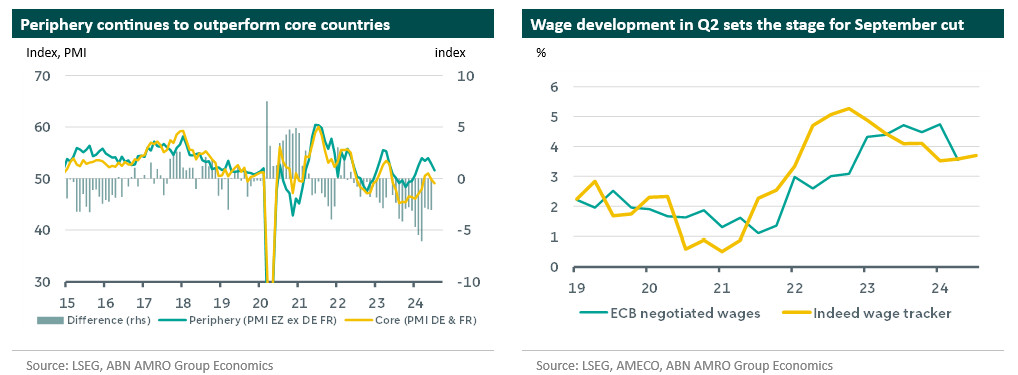Eurozone - The recovery needs more from consumers


Services continues to drive the recovery for the time being, helped by strong tourist inflows and, more recently, a host of summer cultural events. This is helping to offset weakness in manufacturin. Services inflation remains on the high side, but falling wage growth comes as a welcome relief. The slowing in negotiated wages gives the ECB the green light to restart rate cuts in September.
Over the summer, major events influenced the eurozone's economy: elections in France, budget talks in Germany, the Olympics, and football championships. Since our last monthly update in June incoming GDP data showed the eurozone economy continued its expansion in Q2 at a similar pace as in Q1 (+0.3 q/q). Periphery countries carried growth, benefitting from tourism and recovery fund investments while Germany contracted against expectations (-0.1 q/q). Headline GDP was slightly due to volatile Irish data. As such, the 0.3% q/q number likely overstates EZ strength. Zooming out, the eurozone economic recovery is struggling to gain momentum. We do expect a modest, below-trend growth rate in the near term. We have penciled in 0.3% q/q for Q3 and a slowdown to 0.2% q/q for Q4.
The components of GDP are not published yet, but judging from available data, growth in the past months was driven by the services sector whereas manufacturing, especially in Germany, is still in recessionary territory. In the first few months of the year, the eurozone manufacturing sector seemed to bottom out. But recently, that optimism has faded. So far, the bottoming out in world trade has not yet translated into rising demand for eurozone exports. This is partly because past shocks to competitiveness are still weighing on market share of eurozone exporters. Recent data suggest that a strong demand impulse remains elusive, leaving the manufacturing sector a drag on activity going forward. On the consumer side, private consumption in the eurozone likely continued to expand in Q2 and is set to do so in Q3 as well, helped by real income gains as well as some one-offs such as the Olympics in France (). However, despite solid wage rises, easing inflation and strong labour markets, consumer demand has yet to fully pick up steam, with goods consumption in particular still stagnant. The high savings rate suggests consumers are less willing to spend real income gains, especially in France, the Netherlands and Germany. Over time, we expect rising consumer confidence to drive more normal rates of consumption growth.
In July, showed an unexpected marginal rise to 2.6% from 2.5% in June. The upside surprise was primarily driven by stronger energy inflation. Core inflation held steady at 2.9% despite a marginal fall in services inflation to 4% from 4.1%. Considering the heightened sensitivity around wage developments for the medium term inflation outlook, the sharp fall in Q2 negotiated wage growth – to 3.6% from 4.7% in Q1 – came as a welcome relief. The fall was flattered by base effects in German bonuses, and this measure of wage growth likely to rebound in the near-term. However, much of the current strength in wages is backward-looking, with leading indicators continuing to point to more subdued wage pressures as we move into 2025. Judging from the current economic momentum, and with the disinflationary process proceeding broadly as expected, the case for less restrictive monetary policy continues to strengthen. We expect the ECB to cut interest rates by 25bp at the September 12 ECB meeting, followed by two more 25bp steps before the end of 2024. In 2025, the ECB continues cutting interest rates at a steady once-per-meeting pace until the deposit rate reaches 1.5% in Q3 2025.
